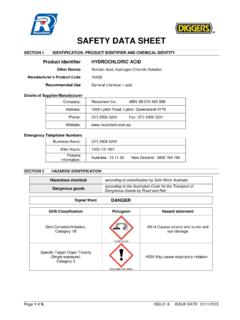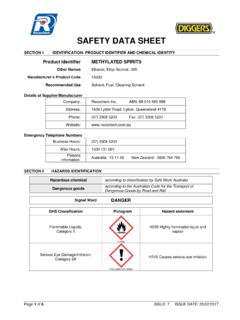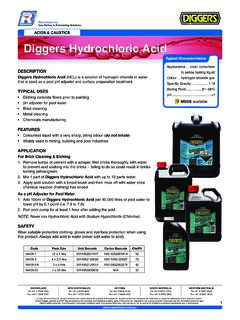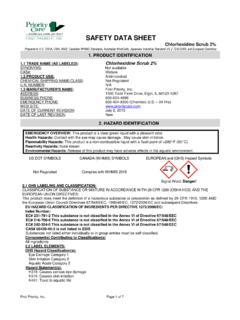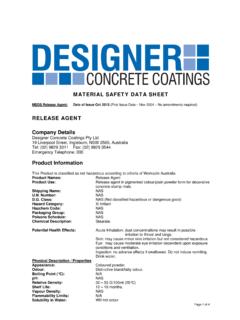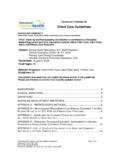Transcription of SAFETY DATA SHEET - Recochem
1 SAFETY data SHEET . SECTION 1 IDENTIFICATION: PRODUCT IDENTIFIER AND CHEMICAL IDENTITY. Product Identifier CAUSTIC SODA. Other Names Caustic, Soda lye, Sodium hydrate, Sodium hydroxide Manufacturer's Product Code 16402. Recommended Use Drain cleaner, soap making ingredient, paint remover Details of Supplier/Manufacturer Company: Recochem Inc. ABN: 69 010 485 999. Address: 1809 Lytton Road, Lytton, Queensland 4178. Phone: (07) 3308 5200 Fax: (07) 3308 5201. Website: Emergency Telephone Numbers Business Hours: (07) 3308 5200. After Hours: 1300 131 001. Poisons Australia: 13 11 26 New Zealand: 0800 764 766. Information: SECTION 2 HAZARDS IDENTIFICATION. Hazardous chemical according to classification by Safe Work Australia according to the Australian Code for the Transport of Dangerous goods Dangerous Goods by Road and Rail Signal Word DANGER. GHS Classification Pictogram Hazard statement Skin Corrosion/Irritation, H314 Causes severe skin burns and Category 1A eye damage CORROSION.
2 Precautionary statements: GENERAL. P101 If medical advice is needed, have product container or label at hand P102 Keep out of reach of children P103 Read label before use PREVENTATIVE. P260 Do not breathe dusts or mists P264 Wash thoroughly after handling Page 1 of 6 ISSUE: 5 ISSUE DATE: 03/03/2015. Product: CAUSTIC SODA. P280 Wear protective gloves/eye protection/face protection RESPONSE. P301 + P330 +. IF SWALLOWED: Rinse mouth. Do NOT induce vomitting P331. P303 + P361 + IF ON SKIN (or hair): Take off contaminated clothing and wash before reuse. P353 Rinse skin with water/shower IF INHALED: Remove victim to fresh air and keep at rest in a position P304 + P340. comfortable for breathing P305 + P351 + IF IN EYES: Rinse cautiously with water for several minutes. Remove contact P338 lenses, if present and easy to do. Continue rinsing P310 Immediately call a POISON CENTER or doctor/physician P363 Wash contaminated clothing before reuse STORAGE.
3 P405 Store locked up DISPOSAL. P501 Dispose of contents/container in accordance with local regulations SECTION 3 COMPOSITION AND INFORMATION ON INGREDIENTS. Ingredients Names and Proportions Chemical Entity CAS Number Proportion (%). Sodium Hydroxide 1310-73-2 > 98. SECTION 4 FIRST AID MEASURES. Description of necessary first aid measures Keep victim calm and remove to fresh air if safe to do so. If rapid recovery Inhalation: does not occur, transport to nearest medical facility for additional treatment. DO NOT DELAY. If spilt on skin or hair, immediately drench with running water and remove contaminated clothing. Continue to wash skin and hair with Skin Contact: plenty of water until advised to stop by the Poisons Information Centre /. doctor. For skin burns, cover loosely with a clean, dry, sterile dressing until medical help is available. DO NOT DELAY. If in eyes, hold eyes open, flood with water for at least 15.
4 Eye Contact: minutes or until advised by the Poisons Information Centre / doctor. DO NOT DELAY. Do NOT induce vomiting. If victim is alert, rinse mouth and Ingestion: drink 1/2 to 1 glass of water to help dilute the material. Seek immediate medical assistance. Symptoms caused by exposure May cause respiratory irritation, including breathing difficulty, lung Inhalation: inflammation, sneezing and throat swelling. A severe irritant. May include burning sensation, redness, swelling and/or Skin: blisters. A severe irritant. Corrosive to eyes; contact can cause corneal burns. May Eye: include pain or burning sensation, redness, swelling and/or blurred vision. May result in nausea, vomiting, diarrhoea, abdominal pain and chemical burns Ingestion: to the gastrointestinal tract. Medical attention and special treatment Treat symptomatically. Page 2 of 6 ISSUE: 5 ISSUE DATE: 03/03/2015. Product: CAUSTIC SODA. SECTION 5 FIRE FIGHTING MEASURES.
5 Suitable extinguishing equipment Not combustible, however, if material is involved in a fire use: water fog or fine water spray, foam, dry chemical powder, carbon dioxide. Specific hazards arising from the chemical Reacts violently with water. Decomposes on heating emitting toxic fumes. Special protective equipment and precautions for fire fighters Wear full protective clothing and self-contained breathing apparatus. Hazchem code 2W. SECTION 6 ACCIDENTAL RELEASE MEASURES. Personal precautions, protective equipment and emergency procedures Avoid contact with spilled or released material. Shut off leaks, if possible without personal risks. Isolate hazard area and deny entry to unnecessary or unprotected personnel. Wear protective equipment to prevent skin and eye contact and breathing dust. Work upwind or increase ventilation. Environmental precautions Use appropriate containment to avoid environmental contamination.
6 Prevent from spreading and entering waterway using sand, earth or other appropriate barriers. Ventilate contaminated area thoroughly. If contamination of sewers or waterways has occurred advise local emergency services. Methods and materials for containment and cleaning up Cover with damp absorbent inert material, sand or soil. Avoid generating dust. Caution heat may be evolved on contact with water. For small spills (< 1 drum), transfer by mechanical means to a labelled, sealable container for product recovery or safe disposal. Allow any residues to evaporate or use an appropriate absorbent material and dispose of safely. For larger spills (> 1 drum), transfer by means such as a vacuum truck to a salvage tank for recovery or disposal. Do not flush residues with water. Retain as contaminated waste. Allow any residues to evaporate or use an appropriate absorbent material and dispose of safely. SECTION 7 HANDLING AND STORAGE.
7 Precautions for safe handling Non-combustible material. Avoid skin and eye contact and breathing dust. Handle and open containers with care in a well-ventilated area. Ensure that the workplace is ventilated such that the Occupational Exposure limit is not exceeded. Wash thoroughly after handling. Do not eat, drink or smoke in contaminated areas. Conditions for safe storage, including any incompatibilities Store in a well-ventilated area, away from sunlight, ignition sources and other sources of heat. Keep away from incompatible materials (see SECTION 10). SECTION 8 EXPOSURE CONTROLS AND PERSONAL PROTECTION. Exposure control measures From National Occupational Health & SAFETY Commission (NOHSC) Worksafe Australia - Sodium hydroxide: 2mg/m (peak limitation) STEL. Biological monitoring No biological limit allocated. Engineering controls Ensure that adequate ventilation is provided. Maintain air concentrations below recommended exposure standards.
8 Avoid generating and inhaling mists and vapours. Keep containers closed when not in use. Page 3 of 6 ISSUE: 5 ISSUE DATE: 03/03/2015. Product: CAUSTIC SODA. Individual protection measures Eye and face protection: Wear SAFETY goggles. Use solvent resistant gloves, nitrile for longer term protection or PVC and Skin protection: neoprene for incidental splashes. If work practices do not maintain airborne level below the exposure standard, use appropriate respiratory protection equipment. When using respirators, select an appropriate combination of mask and filter. Select a Respiratory protection: filter for organic gases and vapours (boiling point > 65 C). Respirators should comply with AS1716 or an equivalent approved by a state/territory authority. Thermal hazards: Not applicable. SECTION 9 PHYSICAL AND CHEMICAL PROPERTIES. Appearance: White Solid Odour: None Odour threshold (ppm): data not available pH: (1% solution in water).
9 Melting point/freezing point ( C): 318. Initial boiling point and boiling range ( C): 1390. Flash point ( C): data not available Evaporation rate (Butyl acetate = 1): data not available Flammability: Non-combustible Upper/lower flammability or explosive limits (%): data not available Vapour pressure (kPa @ 20 C): data not available Vapour density (air = 1 @ 15 C): data not available Density (g/ml @ 20 C): Solubility (kg/m3): Miscible with water Partition coefficient: n-octanol/water: data not available Auto-ignition temperature ( C): data not available Decomposition temperature ( C): data not available 2. Kinematic viscosity (mm /s @ 25 C): data not available SECTION 10 STABILITY AND REACTIVITY. Reactivity Stable under normal conditions of use. Chemical stability Stable under normal conditions of use. Possibility of hazardous reactions Stable under normal conditions of use. Page 4 of 6 ISSUE: 5 ISSUE DATE: 03/03/2015.
10 Product: CAUSTIC SODA. Conditions to avoid Exposure to water vapour. Incompatible materials Acids, aluminium, tin, zinc and chlorinated hydrocarbons. Hazardous decomposition products None. SECTION 11 TOXICOLOGICAL INFORMATION. Acute toxicity: LD50 data not available. Contact with skin will result in severe irritation. Corrosive to skin may Skin corrosion/irritation: cause burns. Serious eye A severe eye irritant. Corrosive to eyes; contact can cause corneal damage/irritation: burns. Contamination of eyes can result in permanent injury. Respiratory or skin data not available. sensitisation: Germ cell mutagenicity: Not expected to be mutagenic. Carcinogenicity: Not expected to be carcinogenic. Reproductive toxicity: Not expected to impair fertility. Specific Target Organ Swallowing can result in nausea, vomiting, diarrhoea, abdominal pain and Toxicity (STOT) . chemical burns to the gastrointestinal tract. single exposure: Specific Target Organ Toxicity (STOT) data not available.
